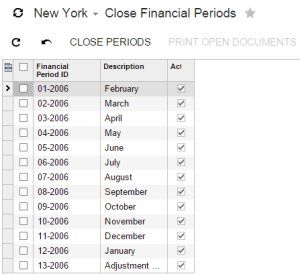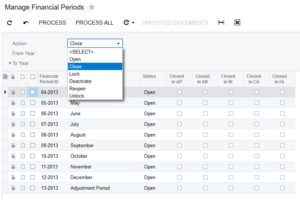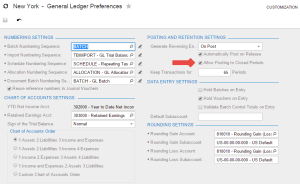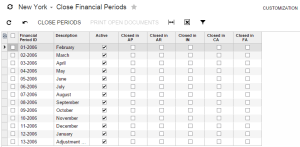Acumatica Period and Year End Closing Procedure
Period-End Closing Procedures
Acumatica ERP provides multiple options to let you configure period-closing procedures in accordance with your company policies.
Employees at your company can decide when to perform period-end closing procedures. You do not need to postpone period-end closing to allow recording of certain transactions dated in the period to be closed. Posting transactions to closed periods is possible if the Allow Posting to Closed Periods option on the General Ledger Preferences (GL.10.20.00) form is selected.
At any point in time, you can have multiple active periods. Activating a period doesn’t require closing a previous one.
Period-End Closing
Follow your company’s internal procedures to determine the prerequisites to closing a financial period. Your company might require the following tasks to be completed before a period is closed:
- Performing allocations
- Generating recurring documents and releasing them
- Performing revaluation of foreign currency accounts
- Generating and reviewing the trial balance
To close a period in General Ledger, you first have to perform the closing operations in the subledger modules you are using. These include the following:
- Accounts Receivable
- Accounts Payable
- Cash Management
- Inventory
- Fixed Assets
A period is considered closed only when it has been closed in the General Ledger module by using the Close Financial Periods (GL.50.30.00) form. This form gives you information about the status of periods in the Accounts Payable, Accounts Receivable, Cash Management, Inventory, and Fixed Assets modules. If a period has not been closed in any of the modules, you can close it there.
Closing a period in General Ledger initiates generation of auto-reversing batches if the Generate Auto-Reversing Entries on Period Closing is selected on the General Ledger Preferences form. You should never close the last activated financial period; always activate one or more financial periods before you close a period.
Closing a Period in a Subledger Module
A financial period can be closed in the General Ledger module only if it has been closed in the Accounts Payable, Accounts Receivable, Cash Management, Inventory, and Fixed Assets modules. You need to perform the closing procedure in only the subledger modules that are activated in your system.
A period can be closed in Accounts Payable, Accounts Receivable, Cash Management, Inventory, and Fixed Assets only if in the module there are no documents with Released (Unposted), Balanced, or On Hold status that are to be posted to this period.
 To close a period in Accounts Payable, use the Close Financial Periods (AP.50.60.00) form.
To close a period in Accounts Payable, use the Close Financial Periods (AP.50.60.00) form.- To close a period in Accounts Receivable use the Close Financial Periods (AR.50.90.00) form.
- To close a period in the Cash Management module, use the Close Financial Periods (CA.50.60.00) form.
- To close a period in the Inventory module, use the Close Financial Periods (IN.50.90.00) form.
- To close a period in the Fixed Assets module, use the Close Financial Periods (FA.50.90.00) form.
When you close a given financial period, all preceding active periods will be closed as well.
| If, during the initial stage of using Acumatica ERP, you decided to add one or more periods before the first financial period, you can activate those periods (even if you have one or more closed periods) and post the required transactions to them. Later, to be able to close any of the later periods, you should close those periods first. |
Year-End Closing
In Acumatica ERP, year-end closing is performed automatically when you close the last period of the financial year. Thus, closing the last period of the financial year should be done only when the company is ready to close the General Ledger financial year. Period-end closing for the last period of the financial year must be completed in all other active modules before users can perform year-end closing in the General Ledger module.
The year-end closing may include the following stages:
- At the end of the financial year, generating periods for the new year and activating at least one of them
- Carrying out the operations according to your company’s “year-end“ checklist
- Closing the last period in General Ledger and fulfilling all the requirements
During closing of the financial year, the balance of YTD Net Income account updates the Retained Earnings account, which accumulates the net income over years. After that, the balance of the YTD Net Income account is reset to zero for a new financial year. The balances of the balance sheet accounts are simply transferred into the new financial year, while balances of other accounts are reset to zeros.
Acumatica 2018 R2 Functionality Update
Starting with Acumatica 2018 R2 the GL menu option for closing periods and years has been changed from Close Financial Periods to Finance | Manage Financial Periods. Behind the menu name c hange is also a functionality change. With Acumatica 2018 R2 there are now Action options:
hange is also a functionality change. With Acumatica 2018 R2 there are now Action options:
- Open: Changes the status of the selected financial periods (or all periods) from Inactive to Open.
- Close: Changes the status of the selected financial periods (or all periods) from Open to Closed, if the period has no unposted documents.
- Lock: Changes the status of the selected financial periods (or all periods) from Closed to Locked, if the period has no unposted documents.
- Deactivate: Changes the status of the selected financial periods (or all periods) from Open to Inactive, if the period has no unposted documents.
- Reopen: Changes the status of the selected financial periods (or all periods) from Closed to Open.
- Unlock: Changes the status of the selected financial periods from Locked to Closed.

